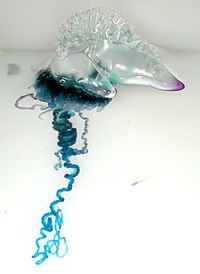
Photo from wikipedia
Simple Summary Eucryptorrhynchus scrobiculatus and E. brandti are boring weevils of Ailanthus altissima (tree-of-heaven) and coexist on the same host A. altissima. In previous studies, through behavioral observation, we learned… Click to show full abstract
Simple Summary Eucryptorrhynchus scrobiculatus and E. brandti are boring weevils of Ailanthus altissima (tree-of-heaven) and coexist on the same host A. altissima. In previous studies, through behavioral observation, we learned that, during the oviposition process, these weevils need to use their rostra to excavate an oviposition hole. However, the specific morphology of the rostra of the two weevils and the egg-laying mechanism during the oviposition process currently remain unknown. The morphological analysis attempts to link biological structure and function to specific environmental or behavioral characteristics, and this method has become an indispensable tool in the process of elucidating and interpreting patterns. Therefore, the morphologic characteristics of the rostra in E. scrobiculatus and E. brandti were examined and compared by scanning electron microscopy and micro-CT. This study not only plays an important role in exploring the excavating mechanism during oviposition of E. scrobiculatus and E. brandti, but also provides new insight for explaining the coexistence of two weevil species in the same host. Abstract (1) Eucryptorrhynchus scrobiculatus and E. brandti (Coleoptera: Curculionidae: Cryptorrhychinae) are both pests of Ailanthus altissima, found in China. During ovipositing, gravid females of the two weevils need to excavate a cavity in the oviposition substrate with their rostrum, while their oviposition sites are different. (2) In this study, to explore the boring mechanism of E. scrobiculatus and E. brandti during ovipositing, the morphologic characters of the rostra of two weevils were studied in detail by scanning electron microscopy and micro-CT. (3) Their rostra appear similar, but the rostrum surface of E. scrobiculatus is rougher than that of E. brandti; their fine structures of rostrum and sensilla distribution are similar, but the sensilla twig basiconica 3 is distributed at the apex of labial palpus in E. brandti females, while not at the apex of labial palpus in E. scrobiculatus females; their rostra are hollow and their cuticle thickness is constantly changing, but the proportion of the whole rostrum tube cuticle in E. scrobiculatus is significantly larger than that of E. brandti. The above structural differences make E. scrobiculatus more conducive to oviposition in the soil and E. brandti more conducive to oviposition in the trunk of A. altissima. (4) Overall, this study not only plays an important role in exploring the excavating mechanism during the oviposition of the two weevils, but also provides new insights into the coexistence of two weevil species on the same host A. altissima.
Journal Title: Insects
Year Published: 2023
Link to full text (if available)
Share on Social Media: Sign Up to like & get
recommendations!